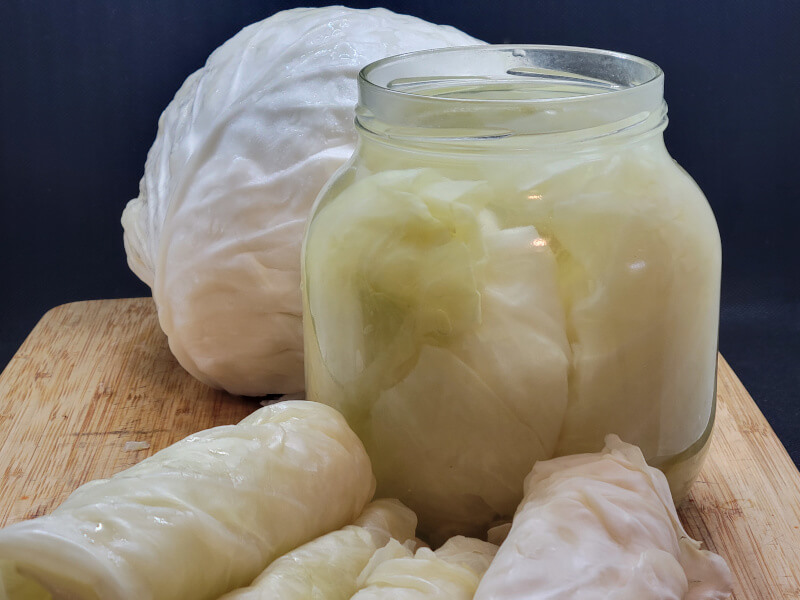Homemade Sour Rolled Cabbage Leaves that are used to make Soured Cabbage Rolls. Once you try these, you’ll leave the plain ones behind. These Sour Rolled Cabbage Leaves are just the best for Cabbage Rolls, and specifically made for them! Make a bunch of these up to have them on standby anytime you want to make Cabbage Rolls. The Cabbage leaves are boiled to soften the leaves. With the stem removed, the leaves are rolled up to place inside the jars. Instead of just the Salt Brine used in the Sauerkraut recipe, we use a bit of Vinegar to jump start that tang.
Store bought Rolled Cabbage Leaves
The Gloria Rolled Cabbage Leaves are the ones used for Soured Cabbage Rolls and are absolutely fantastic. Using regular Cabbage leaves to make this dish just won’t do. The Soured Cabbage Leaves really elevates the flavors. Once you try it, you will never want to use regular Cabbage leaves for Cabbage rolls again.

Gloria Rolled Cabbage Leaves Ingredients
Cabbage Leaves, Water, Salt And Citric Acid.

Sour Rolled Cabbage Leaves Ingredients
Cabbage, Water, White Vinegar, Sea Salt
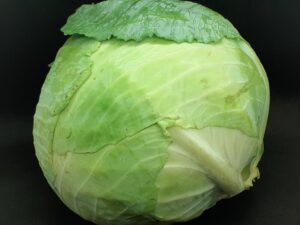
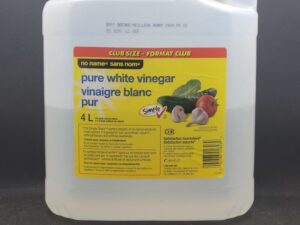
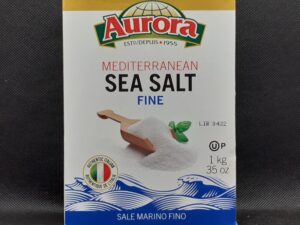
Sour Rolled Cabbage Leaves Brine
The Brine for the Cabbage leaves is easy enough and are added to a bowl to be mixed until the salt is completely dissolved. Then poured into the jars to completely cover the rolled leaves. Made of the following ingredients and amounts. Double or Triple the amounts as you need to ensure you have enough.
- 3 Cups Water
- 1 Cup of White Vinegar. White Wine Vinegar can also be used.
- 1 Tbl Sea Salt
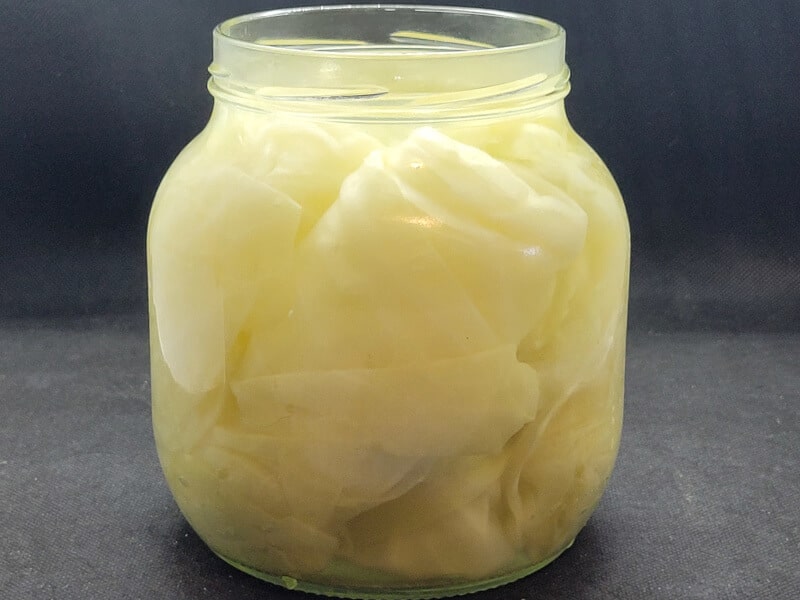
How to Boil Cabbage
Depending on if you plan to use the entire Cabbage for the leaves, or just enough leaves and using the remaining Cabbage for other dishes, will determine the best approach to boiling Cabbage.
How to Boil a Whole Cabbage
If you plan on boiling the entire Cabbage. Then by far the easiest method is to core the Cabbage and place into a pot with water to cover and bring to a boil. This loosens up the Cabbage and allows a bit more water into the Cabbage to separate the leaves. Then, one by one you can use tongs to pick up by the stem of each outer leaf and remove as they soften.
This method is good if you plan on making multiple jars of Soured Cabbage Leaves, using the entire Cabbage.
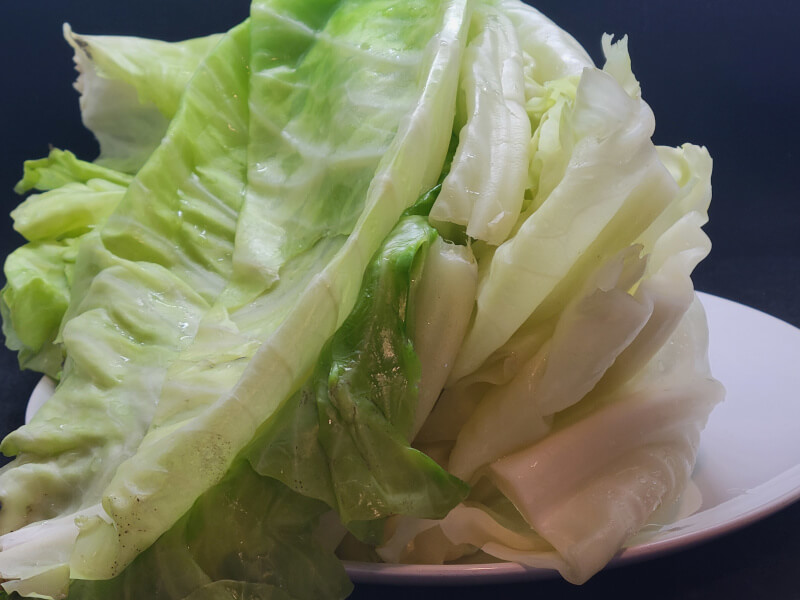
How to Boil Cabbage Leaves
You may want to only cook the outside leaves and avoid cooking the Cabbage through in order to use it for other recipes. Especially where you have a large Cabbage.
Use a meat hook to pierce right through the core stem of the Cabbage. This is optional, but it does make it way easier to handle while boiling. You only need to boil until the outer leaves are softened, just a few minutes. Then slice at the stem for each leaf you want to remove and transfer the Cabbage leaf with tongs to a large bowl or strainer, being careful not to rip the leaf. Repeat slicing at the root stem and removing until you have enough leaves. Then remove the Cabbage out of the pot and use for other recipes.
Whenever boiling Cabbage, I never really use the entire Cabbage for just Cabbage Rolls or Soured Cabbage Leaves. I tend to get the amount of leaves desired and use the remaining Cabbage for other uses. For these other uses, I don’t want the Cabbage boiled at all. It is for this reason, I use a meat hook to assist in boiling the Cabbage. Just until the outer leaves are pliable and trim them off. Making the whole process of removing the leaves while handling the entire Cabbage much easier.
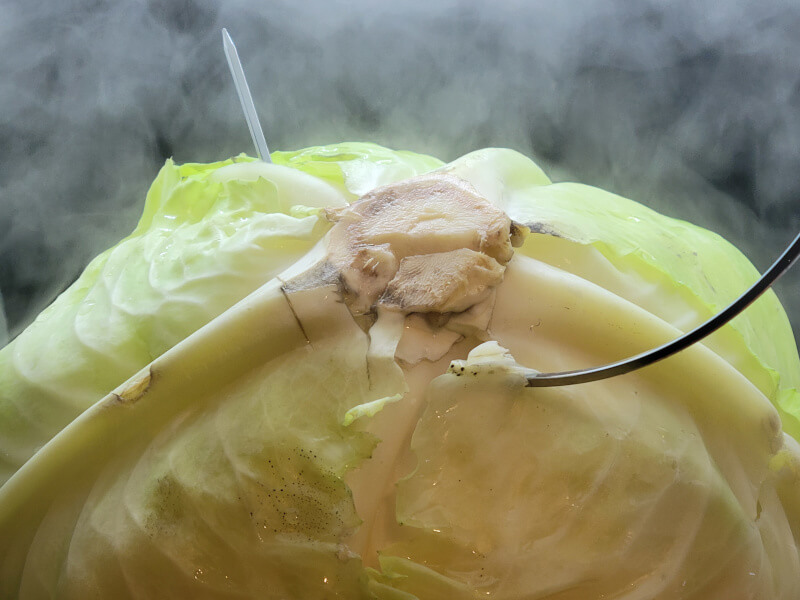
Softening Cabbage Leaves
Once you have all the leaves you want for Sour Cabbage Leaves, boil them again until very pliable. This step softens the Cabbage leaves even more and makes it much easier to roll. Boil them for about 10 minutes, then remove and let cool. You don’t want them too soft. Just soft enough where the leaves can be stacked and rolled without breaking the leaves.
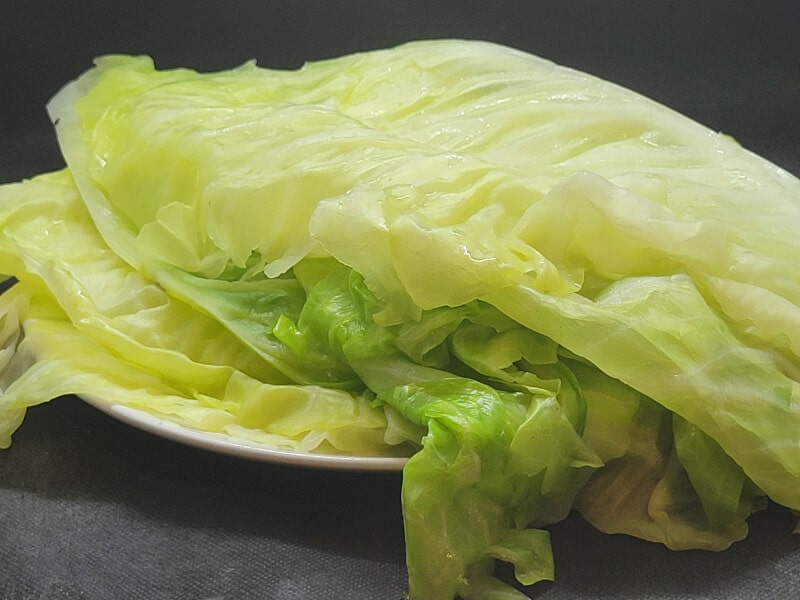
Remove the Stem from Cabbage Leaves
Each Cabbage leaf will have a very thick stem at the base that needs to be trimmed down thin. Some will completely remove it. Position your knife parallel to the Cabbage leaf. Trim off the thick stem so that it is roughly the same thickness as the leaf, maybe a tad thicker. With larger Cabbage leaves, you can remove the stem completely and use half of the Cabbage leaf for one Cabbage Roll.
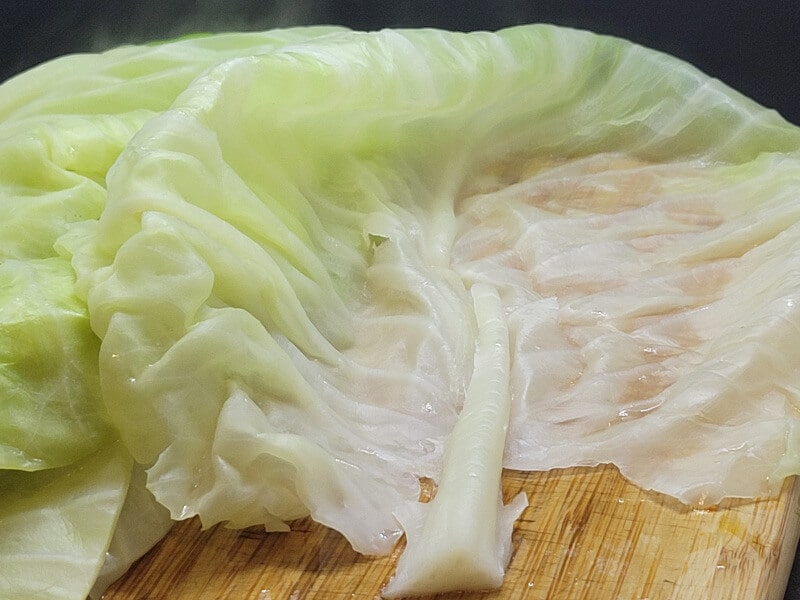
How to make Sour Rolled Cabbage Leaves
The Cabbage Leaves need to be boiled just until they are softened, where they can be stacked and rolled without breaking.
- Depending on the size of the softened Cabbage leaves. Place 2–3 leaves on top of each other and fold in the sides so that the width is about 4–5 inches wide. Larger leaves can be sliced in half.
- Roll tightly and transfer to the glass jar, and repeat until the jar is packed relatively tight.
- Pour over the brine, making sure the rolled Cabbage Leaves are completely submerged. Use a spoon or fork and nudge the rolls a bit to get rid of any air bubbles.
- Store away with the lid fitted tight in a dry place. Place it on top of a small plate to catch any overflow. Every day or so, loosen the lid to release any trapped air.
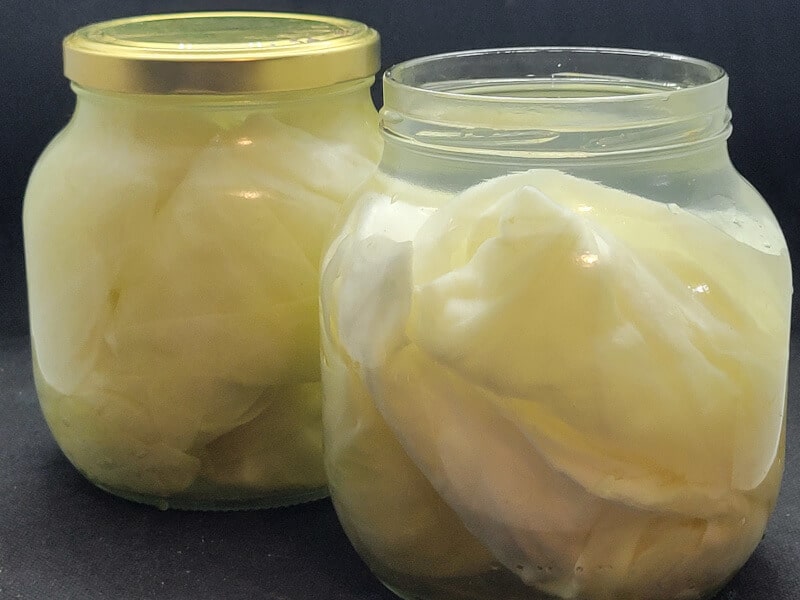
Fermentation Time
The ferment time is typically around 2-3 weeks or more. Depending on how sour you like it, just the same as Sauerkraut. The more sour, the more health benefits that can be derived from it. Once it soured to your liking, it can be used to make Cabbage Rolls or stored in the fridge to significantly slow down the fermentation process until you are ready to make Cabbage Rolls.
With the added vinegar, these Cabbage Rolled Leaves can be used the next day (less tangy, but still there), fermented and then refrigerated or just refrigerated until ready to use. My preference is to ferment them a few weeks, even a month or so, and then use for Cabbage Rolls, or refrigerate after fermenting a few weeks. But use as you see fit.
It is important that every day or so, open the lid to release the air to avoid pressure building up in the jar and potentially exploding the jar from too much pressure. Once it is refrigerated the fermentation is considerably slowed down, almost to a stop, and this won’t be needed. While it is out at room temp and fermenting, it is very important to do this, just as with anything else fermented in an anaerobic environment.
While with Soured Rolled Cabbage Leaves the fermentation is not as fast as Sauerkraut, if any at all because the leaves were boiled, kiling off much of the bacteria that causes fermentation. It is still good practice to release any trapped air from the jars. Fermentation still takes place, it’s just at a much slower rate than Sauerkraut which uses fresh Cabbage that hasn’t been boiled, preserving the naturual bacteria within the leaves.
What to do with Leftover Cabbage
The entire Cabbage can be used up in one go. The outer leaves to make the Rolled Soured Cabbage Leaves, and the leftover fresh Cabbage can be used for Coleslaw or Sauerkraut.
Cabbage can also be shredded for Egg Rolls or chopped or torn for Steamed or Fried Cabbage or included when making Roasted or Braised Vegetables. Also used in Cabbage Roll Soup, Cabbage Meat Soup, or Cabasta. For all of these recipes, the Cabbage can be salted and then portioned and frozen.
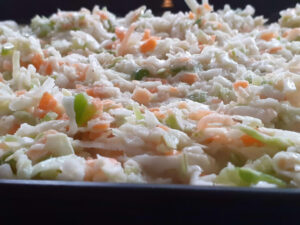
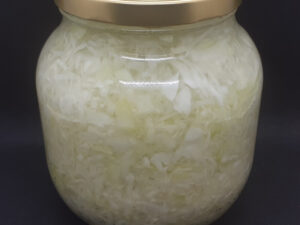

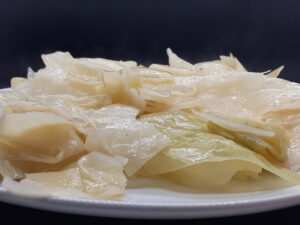

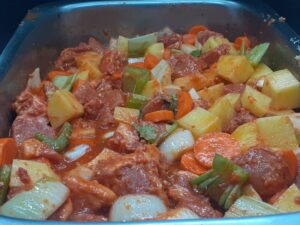
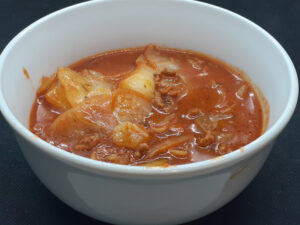
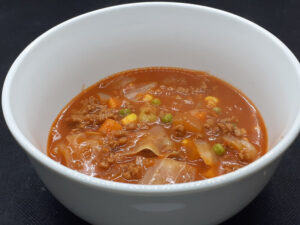

Salting Cabbage
Salting Cabbage is a step in removing any bitterness from the Cabbage and softening them. It is a preparation I take before freezing Cabbage.
Chop, shred or tear the Cabbage depending on how you plan on using the Cabbage later. Add 2 % Salt to the Cabbage, or about 1/2 Tbl of Sea Salt for every 1 lb (ca. 454 g) of Cabbage. Mix well, crushing the Salt into the Cabbage, and set it aside for 30 minutes or longer. Then squeeze out the Juices from the Cabbage and portion into Ziploc bags to freeze. Squeeze out as much air as you can.
The Frozen Cabbage can be used for all of the above recipes, except Coleslaw or Sauerkraut. For these, the Cabbage needs to be fresh or just the outer leaves boiled for the sour cabbage leaves.

Equipment
- 1 Large Pot
- 1 Glass Jar that holds about 1.5 L or 52 oz.
- 1 Meat Hook to handle the cabbage – optional
- 1 Bowl for the brine
Ingredients
- 1 Head Cabbage
- 3 C Distilled Water
- 1 C White Vinegar
- 1 Tbl Sea Salt
Instructions
- Combine Salt, Vinegar & Water in a bowl to mix until the salt is completely dissolved and set aside. Pierce the cabbage through the root with a meat hook (optional for easier handling). Place it in a pot, fill with water to measure, remove the cabbage, and bring the water to a boil.
- Boil the cabbage for 5–8 minutes until the outer leaves soften. Slice at the thick root stem and peel off leaves with tongs as they soften. Repeat until you have 12 leaves.
- Remove the remaining cabbage for other recipes, or repeat the process for more leaves. Return peeled leaves to the boiling water for 10 minutes until pliable for rolling. Don't over boil these, just until they are soft enough that they can be stacked and rolled without breaking.
- Remove and rinse the leaves with cold water, then slice off the thick stem. Stack 2–3 leaves, fold the sides to 4–5 inches wide, roll tightly, and pack into a jar. Large leaves can be halved before rolling.
- Pour brine over the rolls, ensuring they’re fully submerged. Remove air bubbles with a spoon, cover with the lid and store in a dry place. Use the next day, or ferment for 2–3 weeks before refrigeration.Every day or so, open the lid to release pressure and avoid potentially exploding the jar from trapped pressure.
